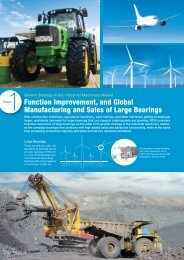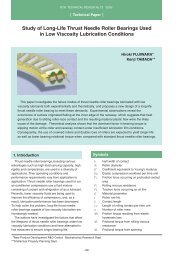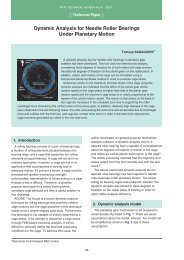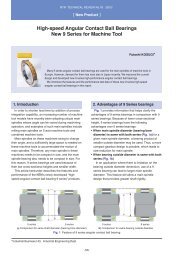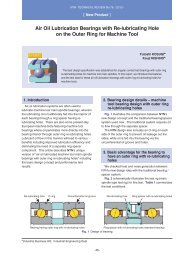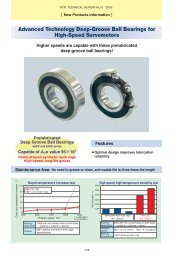Special Issue; Products for Industrial Machinery - NTN
Special Issue; Products for Industrial Machinery - NTN
Special Issue; Products for Industrial Machinery - NTN
Create successful ePaper yourself
Turn your PDF publications into a flip-book with our unique Google optimized e-Paper software.
<strong>NTN</strong> TECHNICAL REVIEW No. 742006<br />
4.1 Friction-wear characteristics<br />
The Hybrid Bearphite, which is provided with the<br />
insert-molded resin sliding material in its bore surface<br />
was combined with an Ni-plated shaft and was run<br />
under a radial load of 29.6 N and a running speed of<br />
240 min -1 . The resultant friction coefficient is<br />
graphically plotted in Fig. 10. For comparison, the<br />
characteristics of a sintered oil-impregnated bearing<br />
(mineral oil-impregnated copper sintered bearing) are<br />
also plotted in the same diagram.<br />
The friction coefficient of the sintered metal oilimpregnated<br />
bearing was high during the earliest<br />
stage of operation, but eventually decreased as<br />
running-in proceeded, and finally became stable at<br />
0.06. In contrast, the friction coefficient with the Hybrid<br />
Bearphite always remained stable at about 0.06 even<br />
at the earliest stage of operation. The wear with the<br />
sintered metal oil-impregnated bearing after 500 hours<br />
of operation reached 10m while the Hybrid<br />
Bearphite was as small as 6m. This means that the<br />
friction-wear quality of the Hybrid Bearphite sliding<br />
bearing is better than that of the sintered metal oilimpregnated<br />
bearing.<br />
In a test with aluminum shafts, the sintered metal<br />
oil-impregnated bearing caused the aluminum shaft to<br />
be worn rapidly. In contrast, our Hybrid Bearphite<br />
exhibited per<strong>for</strong>mance equivalent to that shown in Fig.<br />
10.<br />
Dynamic friction coefficient<br />
0.25<br />
0.20<br />
0.15<br />
0.05<br />
0.00<br />
0<br />
Radial load: 29.6 N<br />
Running speed: 240 min -1<br />
Counterpart shaft: Ni-plated<br />
Hybrid Bearphite<br />
Sintered<br />
oil-impregnated<br />
bearing<br />
100 200 300 400 500<br />
Duration h<br />
Fig. 10 Friction property of HYBRID BEARPHITE<br />
4.2 Dimensional accuracy<br />
The dimensional accuracy data and features of our<br />
Hybrid Bearphite are summarized in Table 2. The<br />
Hybrid Bearphite boasts dimensional accuracy<br />
comparable to that of a sintered oil-impregnated<br />
bearing. Furthermore, since the resin sliding layer on<br />
the Hybrid Bearphite expands and shrinks relative to<br />
the reference surface, it features extremely small<br />
dimensional variation due to temperature variations<br />
(Fig. 11). Note that greater dimensional variation with<br />
a bearing leads to larger shaft clearance, resulting in<br />
greater variation in running accuracy.<br />
For the Hybrid Bearphite with a bore diameter of 7.5<br />
mm, the resin layer thickness was adjusted to 0.25<br />
mm and the linear expansion coefficient of the resin<br />
layer was assumed to be 14 x 10 -5 /˚C. Thus, the<br />
temperature-dependent variation in the bore diameter<br />
of the Hybrid Bearphite was calculated (reference<br />
temperature: 25˚C) and was compared (Fig. 12), with<br />
that obtained from an ordinary resin sliding bearing<br />
comprised solely of resin material. This diagram also<br />
includes the actual measurement data at 60°C. The<br />
steepness of the straight line representing the<br />
Table. 2 Dimensional properties and characteristics of<br />
sliding bearings<br />
Characteristic<br />
Bore diameter<br />
Outside diameter<br />
Bore roundness<br />
Concentricity<br />
Cylindricity<br />
Dimensional variation<br />
Sliding relative<br />
to aluminum<br />
Sliding relative to<br />
SUM + Ni-plating<br />
Hybrid<br />
Bearphite<br />
5m<br />
15m<br />
10m max.<br />
15m max.<br />
10m max.<br />
<br />
<br />
<br />
Low<br />
temperature<br />
Resin sliding<br />
bearing<br />
15m<br />
15m<br />
50m max.<br />
30m max.<br />
40m max.<br />
<br />
<br />
<br />
High<br />
temperature<br />
Sintered metal<br />
oil-impregnated bearing<br />
5m<br />
15m<br />
10m max.<br />
15m max.<br />
10m max.<br />
<br />
<br />
<br />
Reduction in sintered bore<br />
Shrinking of resin layer<br />
Increase in sintered bore<br />
Expansion of resin layer<br />
Interface is firmly bonded<br />
Reference surface <strong>for</strong> expansion and shrinking<br />
Bearing with smaller change in bore diameter relative to variation in temperature<br />
Fig. 11 Dimensional change of HYBRID BEARPHITE<br />
against temperature change<br />
-112-



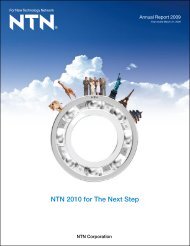
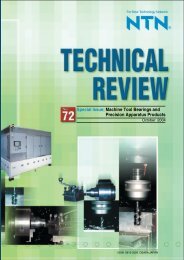
![[New Product] Unit Products for Office Equipment - NTN](https://img.yumpu.com/27154451/1/184x260/new-product-unit-products-for-office-equipment-ntn.jpg?quality=85)
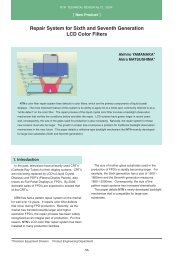
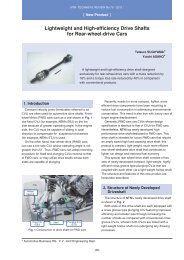
![[New Product] Development of Oil-impregnated Sintered ... - NTN](https://img.yumpu.com/27154427/1/184x260/new-product-development-of-oil-impregnated-sintered-ntn.jpg?quality=85)

